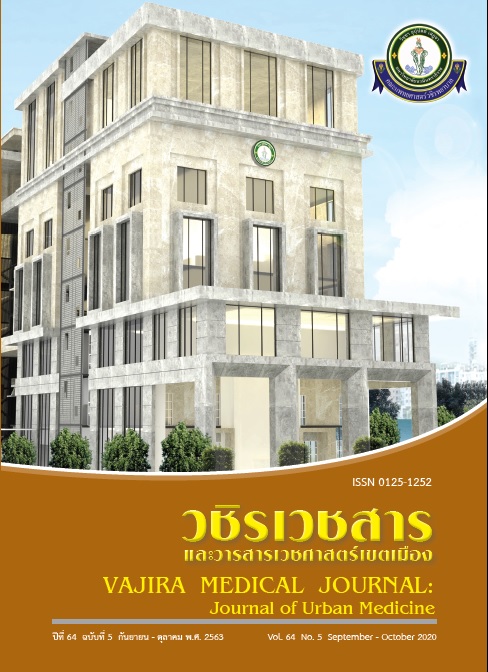The Study on Thailand’s Particulate Matter 2.5 (PM 2.5) Management in Accordance with The World Health Organization (WHO) Guidelines
Main Article Content
Abstract
Objective: To study Thailand’s particulate matter 2.5 (PM 2.5) management in line with the World Health Organization (WHO) guidelines.
Methods: This academic article aims to review about the health effects of PM 2.5 and study Thailand’s solutions. The plan is to analyze national policies, national development plans, environmental situation reports, air pollution and dust management in Thailand and sample countries, namely China, Japan, and Vietnam in conformity with the WHO guidelines covering six areas, i.e. industry, energy, transport, urban planning, power generation, municipal and agricultural waste management.
Results: PM 2.5 affects free radicals balance, induces inflammation in lung tissue and cell death, as well as causes respiratory and cardiovascular disorders. However, Thailand has adopted PM 2.5 solution measures in line with the WHO guidelines and performed in the same way as other sample countries to control PM 2.5.
Conclusions: As PM 2.5 is harmful to health, Thailand has introduced urban pollution management methods followed the WHO guidelines to reduce health problems and enhance people’s quality of life.
Downloads
Article Details
References
Health effects of particulate matter final Eng.pdf [Internet]. [cited 2019 Dec 6]. Available from: http://www.euro.who.int/_data/assets/pdf_file/0006/189051/Health-effects-of-particulatematter-final-Eng.pdf
Science Media Centre (2015). Expert reaction to carcinogenicity classification of five pesticides by the International Agency for Research on Cancer (IARC). [cited 2016 Aug 1].Available from: http://www.sciencemediacentre.org/expert-reactionto-carcino genicity-classification-of-fivepesticides-by-the-international-agency-for-research-on-cancer-iarc/.
BRIEFI-5.pdf [Internet]. [cited 2019 Dec 6]. Available from: http://web.worldbank.org/archive/website00811/WEB/PDF/BRIEFI-5.PDF
WHO | WHO Global Urban Ambient Air Pollution Database (update 2016) [Internet]. [cited 2019 Nov 26]. Available from: http://www.who.int/airpollution/data/cities-2016/en/
World Health Organization, editor. Air quality guidelines: global update 2005: particulate matter, ozone, nitrogen dioxide, and sulfur dioxide. Copenhagen, Denmark: World Health Organization; 2006. p.484.
WHO | WHO Global Urban Ambient Air Pollution Database (update 2016) [Internet]. [cited 2019 Nov 26]. Available from: http://www.who.int/airpollution/data/cities-2016/en/
Pollution Control Department, Ministry of Natural Resources and Environment. Booklet on Thailand State of Pollution 2018. Bangkok, Thailand: S Mongkon Press Limited Partnership;2019.
PM2.5.pdf [Internet]. [cited 2019 Dec 6]. Available from: http://infofile.pcd.go.th/air/PM2.5.pdf
Krishnan RM, Adar SD, Szpiro AA, Jorgensen NW, Van Hee VC, Barr RG, et al. Vascular Responses to Long- and Short-Term Exposure to Fine Particulate Matter. J Am Coll Cardiol. 2012 Nov;60(21):2158–66.
Deng X, Zhang F, Rui W, Long F, Wang L, Feng Z, et al. PM2.5-induced oxidative stress triggers autophagy in human lung epithelial A549 cells. Toxicol In Vitro. 2013;27(6):1762–70.
Deng X, Feng N, Zheng M, Ye X, Lin H, Yu X, et al. PM2.5 exposure-induced autophagy is mediated by lncRNA loc146880 which also promotes the migration and invasion of lung cancer cells. Biochim Biophys Acta Gen Subj. 2017;1861(2):112-25.
Ha S, Hu H, Roussos-Ross D, Haidong K, Roth J, Xu X. The effects of air pollution on adverse birth outcomes. Environ Res. 2014; 134:198–204.
Zhu J, Lee RW, Twum C, Wei Y. Exposure to ambient PM2.5 during pregnancy and preterm birth in metropolitan areas of the state of Georgia. Environ Sci Pollut Res Int. 2019;26(3):2492-500.
Kunugi Y, Arimura TH, Iwata K, Komatsu E, Hirayama Y. Cost-efficient strategy for reducing PM 2.5 levels in the Tokyo metropolitan area: An integrated approach with air quality and economic models. PLoS One. 2018;13(11):e0207623.
General affair division, Ministry of Industry [Internet]. [cited 2020 Aug 17]. Available from: http://www.industry.go.th/center_mng/index.php/2016-04-24-18-07-42/2016-04-24-18-09-38/2016-04-24-18-10-07/item/13480-pm-2-5
Japan Automobile Manufacturers Association (JAMA). PM / PM2.5 in Ambient air & Related Activities in Japan. Tokyo:Japan Automobile Manufacturers Association inc, 2011.
Nguyen TNT, Le HA, Mac TMT, Nguyen TTN, Pham VH, Bui QH. Current Status of PM 2.5 Pollution and its Mitigation in Vietnam. Global Environmental Research; 2018(22):73-83.
China releases 2020 action plan for air pollution | China Dialogue [Internet]. [cited 2019 Nov 11]. Available from: https://www.chinadialogue.net/article/show/single/en/10711-China-releases-2-2-action-plan-for-air-pollution
China sees good start in battle against pollution [Internet]. [cited 2019 Nov 11]. Available from: http://english.www.gov.cn/state_council/ministries/2019/03/04/content_281476547871212.htm
Helping China Fight Air Pollution [Internet]. World Bank. [cited 2019 Dec 11]. Available from: https://www.worldbank.org/en/news/feature/2018/06/11/helping-china-fight-air-pollution
Why China’s War on Pollution Affects the Whole World. Bloomberg.com [Internet]. [cited 2019 Dec 11]; Available from: https://www.bloomberg.com/graphics/2018-china-pollution/


